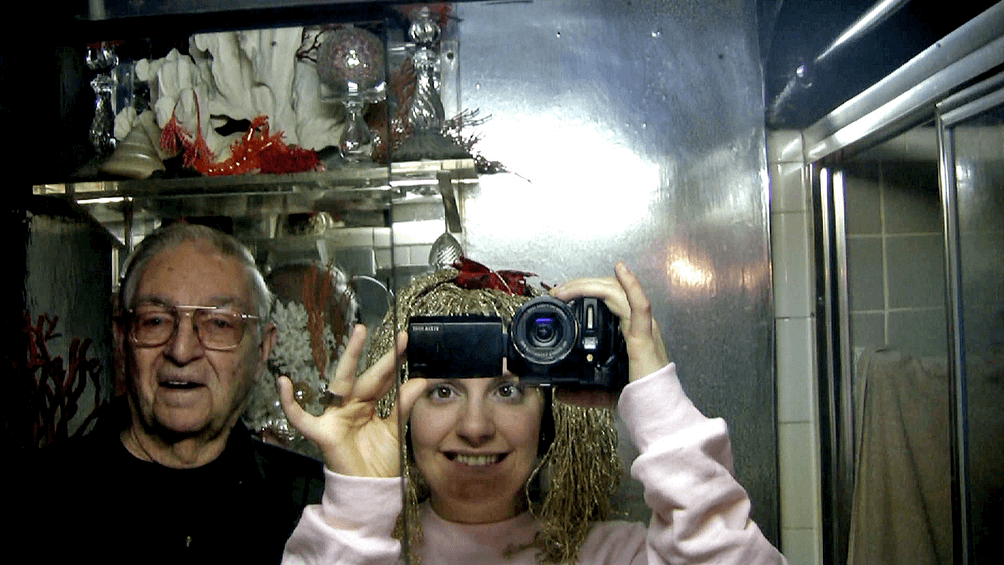Every Story Is a Love Story: On Hilary Knight, Lena Dunham, and Eloise


Hilary Knight and Lena Dunham
still from It’s Me, Hilary: The Man Who Drew Eloise
Question: What book can bring Lena Dunham, Tavi Gevinson, and Fran Lebowitz together in unanimous praise?
Answer: The one, the only, Eloise.
In the first few minutes of HBO’s new, Lena Dunham-produced documentary It’s Me, Hilary: The Man Who Drew Eloise, Dunham, Gevinson, and Lebowitz all extoll the virtues (or “virtues”) of the Plaza Hotel’s most famous and inimitable—if fictional—resident ever: Eloise. For those unfamiliar with the Eloise oeuvre, the children’s book series began in 1955 and centered around Eloise, a little girl in residence at the Plaza Hotel with a wild imagination, a very particular way of talking, and the benefit of having few rules or responsibilities, and thus seemingly all the freedom in the world. She is an unforgettable character, and was the product of an oftentimes tumultuous collaboration between writer Kay Thompson, who died over a decade ago, and illustrator Hilary Knight, who is the subject of this witty, poignant, illuminating film which reveals—among other things—what happens when a creative partnership turns sour. I spoke with Matt Wolf, who directed the film, about why he thinks Eloise is such a timeless character, what appealed to him about this story, and how creative collaborations are—for better or worse—akin to a marriage.
What first got you involved with this project? Did you know much about Hilary Knight beforehand?
Lena Dunham approached me about it, because she is a lifelong Eloise fan, as you can tell from the film—and she’s a friend of mine. She texted me a photo from Hilary’s bathroom and said ‘I’m in Hilary Knight’s bathroom, and he’s the illustrator of Eloise, and it’s incredible.’ And it is this incredible bathroom, as you can see in the film. It’s decorated like an underwater theme room with barnacles and plastic fish. And when we talked later, she said, you know I thought it would be cool to write a profile of him in The New Yorker or something, but then I thought his life is so visual, and his apartment is almost like this autobiographical artwork and what if we documented his apartment as a way to tell his story? And I thought that was a great idea. But then I did a little hunting and I found some really cool vintage Eloise archival footage, and we found out that Hilary had been videotaping his own life for decades, and it turned out there was a bigger story to be told, and we had the material we might need to go into the past and go more deeply into Hilary’s relationship with Kay Thompson and his complicated relationship with Eloise as well.
It really does make perfect sense to tell the story of an illustrator through a visual medium, and I think that’s clearly evidenced in the end result of this film.
Hilary’s so expressive and often autobiographical in his own work and there’s so much to be gleaned from that. And he is a filmmaker. He’s been obsessively documenting his own life forso many years, and it’s amost like he’s been preparing to make this film for a lifetime. It’s so cool to really show the progressions of someone in their life, we were so lucky that he was so good at documenting his own life and also that his drawings can help tell the story too.
Eloise is a not uncomplicated children’s story, and it is probably because of this fact that it is so relentlessly appealing—long after we grow out of most children’s literature, this is the type of book that stays with us. And yet even with the knowledge that most grown women I know love Eloise, it was still surprising to see Fran Lebowitz speaking about her love for the books in your film! How did that happen? And what do you think makes Eloise so appealing for so long?
The way we realized that Fran would be a good character is that Lena’s mom remembered bringing her to a reading at the Drawing Room in Soho in the late 80s and early 90s and different writers chose different books to read, and Fran Lebowitz chose Eloise and that was just so incredible to imagine. And even though Lena was at that reading, she doesn’t really remember it.
It’s kind of hard to really understand why this book has lasted so long, or what’s made it just sort of bleed across the decades. If it was that easy to understand how to make something like that work, then everyone would be making the classics. I think it’s the distinctiveness of the character. She’s so singular and so unique, and she has this daffiness. I think there’s something ultimately about her in her willfullness and her aversion to authority, and that kind of character is going to resonate for young women across generations. And it’s interesting to think about her proto-feminism in the 1950s before all the movements happened, but it’s easy to see why all sorts of young girls who don’t fit into the same mold would want to be like her. And also there’s an aspect of wish-fulfillment to it, in that I can’t think of one kid who wouldn’t fantasize about living in a hotel with no parents, no school, no rules. And I think that is something that’s also super timeless.
I think it is universal among kids, but I also think it’s what so many adults want today—no responsibilities, someone to care for them.
Yeah, totally. She’s like an adult baby in a way too. To not really have to get dressed, to not really have any responsibilities, to just hang out.
Beyond the charm of the book, though, one of the other stories the film tells, is the at-first positive and ultimately doomed partnership between Kay Thompson and Hilary Knight. Although they started out as close as can be, they wound up having loads of bitterness and resentment between them. Do you think there’s any wish to turn back time and erase some of the past?
It’s in this kind of gray area, but I’m sure Hilary would never wish that his relationship to Kay had never happened. She activated his imagination, and she gave him the subject that he wanted to draw. And she changed his life. So there are some things that are completely transformational and wonderful about that relationship, and there’s something devastating about it too. I think that there’s something that Lena and I talked about a lot, because we’ve both worked in many collaborative relationships. These collaborations can be really, really tricky and complicated, and it’s interesting to think about how those get negotiated and those things change over time. And Kay was a legendarily complicated person.
I thought Lena spoke about the perils of this type of collaboration beautifully in the film. It’s hard not to have empathy for Hilary, who the film reveals to be funny and smart and strange and lovely, but ultimately, Eloise was not just his, she was also Kay’s. And so what Lena had to say though about how the reality is that Eloise was the product of both of them, and was sort of like a child that divorced parents fought over, was really astute.
I think a love relationship is a good analogy for a working relationship, you know, it takes two to tango. They both created this thing that was a reflection of both of them. Certainly Eloise is representative of Kay’s personality, but she’s also so identifiable by how she looks, thanks to the illustration. The two components are so melded together, that they’re inseparable and I think that one can’t deny that she’s like a kid to them. And in a way Hilary has been struggling to look after her legacy, but he hasn’t had full custody.
Where does Hilary stand now with everything? Do you think he’ll get to a place where he’s at peace with the fallout with Kay and his subsequent—if not permanent—banishment from Eloise?
I think he’s a little bit torn about it. When you speak to him, the emphasis is always on what he’s working on now. He’s very driven, and has been for decades. But without a doubt, he has the desire to draw Eloise. So without a doubt, he’s not completely at ease or resolved with everything, but at the same time for him, he really wants recognition for all the work he’s done in his life. Because it’s really difficult that the first thing he ever did has overshadowed and eclipsed all of his other accomplishments, which are significant. And I think this film is an opportunity to give him the credit he hasn’t necessarily achieved and also the spotlight that has eluded him throughout his life.
Watch It’s Me Hilary: The Man Who Drew Eloise on HBO tonight, March 23, at 9pm.
Follow Kristin Iversen on twitter @kmiversen
You might also like 




















